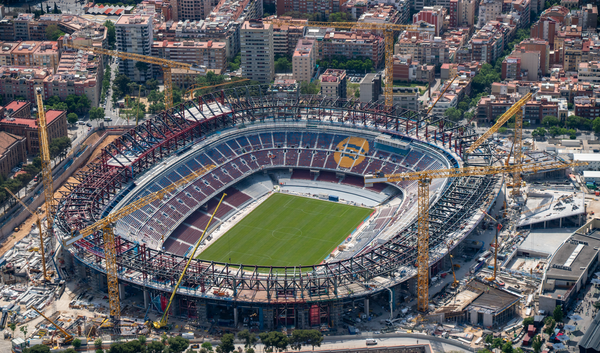Taming the Chaos: Making sense of Barcelona's madness against Real Sociedad
Xavi still needs time to finesse his style, but this was a good example of his adjusting tactically as the game grew

It took me about a week but I’ve finally managed to sit down and gather my thoughts. It would be an understatement to say many Culés were disappointed following Barcelona’s first-half performance in an otherwise exciting 4:1 victory over Real Sociedad last weekend. But seeing the team rally and eventually decimate their opponent rekindled the hope of a rattled fanbase. So who would even dare to criticise the squad after a convincing triumph and a crucial three points against a huge opponent? Well… It’s a bit more complicated than that.
The first 45 minutes can easily be described as madness. But while my first thought was that Barcelona finally clicked with the introduction of the second-half subs, upon further analysis, it turns out the damage had been done even prior to that. Yes, Ansu Fati and Raphinha in particular were the changes Barcelona needed to push them to victory but that was simply the pay-off for a setup that had been established between minutes 15-60.
‘… when you run out of gas, a team like Barça scores four goals. Until we ran out of strength the game was balanced,’ said Imanol Alguacil, the coach of the defeated La Real team after the game. And this answer, or at least a part of it, came after he was asked whether it was Fati who changed the game for Barcelona. His response intrigued me and I had to re-watch the game, paying attention to different sequences and dissecting the stats in intervals to see whether he was right. On the surface, it seemed like such a cliché or standard post-match interview thing to say. But it kept nagging me for a whole week.
And it turns out, he was bang on the money. Yes, Fati killed the game but even prior to his substitution, Barça had killed Real Sociedad.
Let me explain.
Death by a thousand passes
Considering Barcelona’s 538 passes against Real Sociedad are below their average of 611.95 for the last calendar year and also below the figures they’ve managed in every game this season (and pre-season) apart from El Clásico (514) and the Juventus clash (498), this sub-title may be a tad misleading. However, 538 passes in a high-tempo affair were more than enough to reduce Real Sociedad to not much more than blue-and-white cones on the pitch.
But this was not the case for the duration of the whole 90 minutes of the clash. Not at all. La Real are a formidable opponent and Alguacil a very cunning coach. And as he noted himself, they were on par with Barcelona for the majority of the game. Until they weren’t anymore. So what was the breaking point?
Well, by now we know the initial 3-4-3 setup was (mostly) a failure. I say mostly because it’s not exactly the system’s fault but rather the personnel that were initially deployed to execute it. Frenkie de Jong and Gavi didn’t exactly click in that double pivot and having Ferran Torres as an interior is an experiment I wish not to see again. But around minute 15, things started to change.
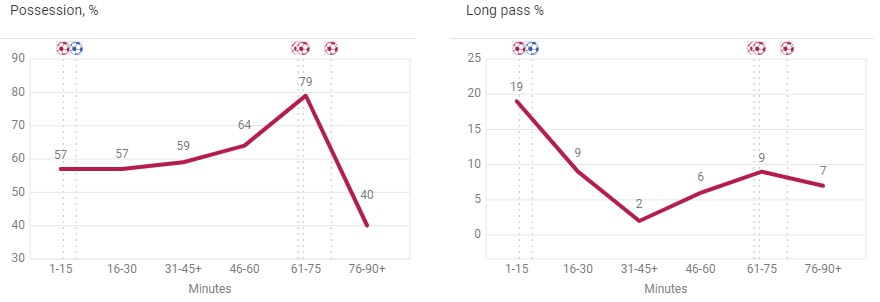
Above, you can see Barcelona’s possession during the game as well as their long pass percentage. Interestingly, while there is an upward trend essentially from the very beginning, we see a spike happen from minute 30 onward. The level until that point is steady, even dropping from 62% between 1-15’ to 53.63% between 16-30’, which is a very important piece of information as that was the moment Pedri and Gavi swapped places.
I’m not exactly a fan of Pedri as the pivot. Not because he can’t do it — of course, he can, he’s Pedri! - but rather, I believe his place should be closer to the opposition’s goal, what for his creativity but also for his long-shot potential. The fact remains, however, that the swap benefited Barcelona’s system, which, again, isn’t a revolutionary statement by this point a week after the game. Still, in the context of tiring out the opposition, it’s also quite important.
While the possession did see a decline, coinciding with Real Sociedad’s game-low PPDA (passes allowed per defensive action) value of 8.17, signalling a more aggressive approach, Barcelona upped the tempo and didn’t let the foot off the gas until the job was done. Wyscout defines match tempo as the number of passes per minute of possession, meaning a higher number would indicate a higher tempo. The Catalans’ tempo increased from 15.78 to 16.65 in the first 15 minutes of the Pedri-Gavi swap and then rose to 18.24 by the end of the first half.
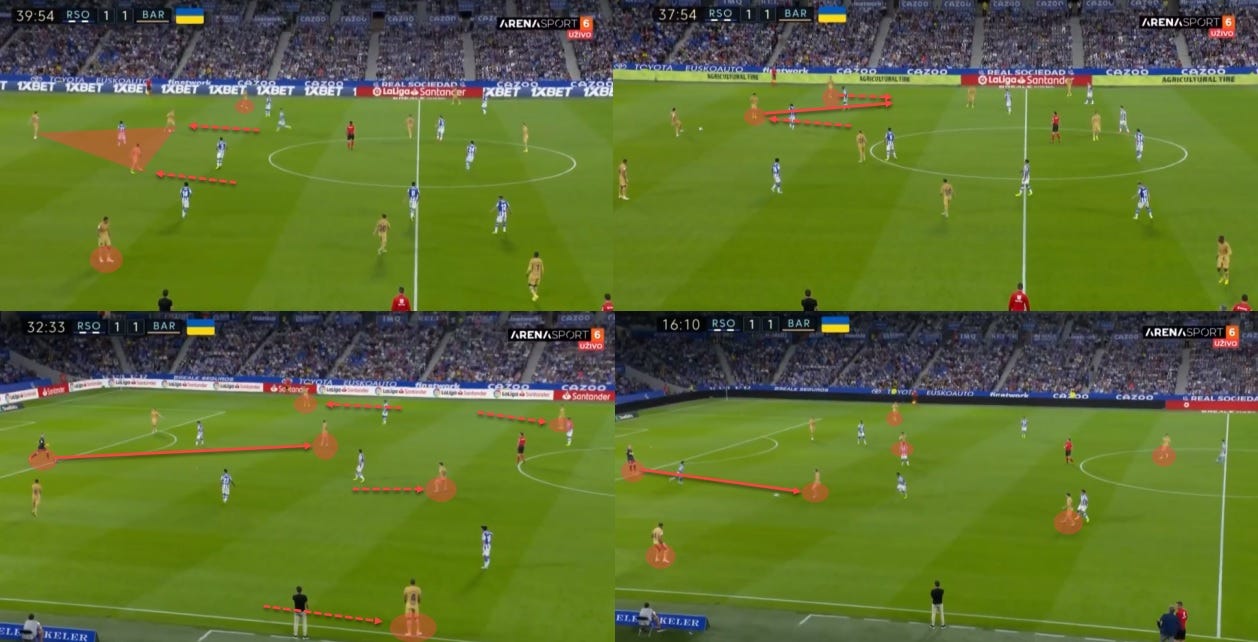
Combined with La Real’s intense press which required a lot of energy, Barcelona’s different build-up patterns also played a big part. Above you can see four instances of successful first phase sequences, all of which include variations of Xavi’s build-up idea. Whether it was one of the pivots in the backline, wide defenders asymmetrical or symmetrical, the key was to create superiorities, which Barcelona accomplished successfully.
But despite the apparent success of the approach, the Catalans weren’t any closer to scoring than they had been prior to the Pedri-Gavi swap. As a matter of fact, their expected goal (xG) values dropped from 0.58 between minutes 1-15’ to 0.15 and 0.16 in the next two quarter-hours respectively. But the long ball percentage, which we can see in the first image of the analysis, also decreased drastically, dropping from 19.4% in the first 15’ to 11.29% (16-30’) and then to only 2.52% (31-45’+). Clearly, despite having slightly less possession, Barcelona were starting to regain control and playing their own game.
Xavi’s idea was to calm down, settle and breathe, as can also be seen from a drastic change in pressing — their PPDA numbers rose from 7.2 to 40 (!!) and then to 15.75, meaning they were happy to let Real Sociedad construct play too.
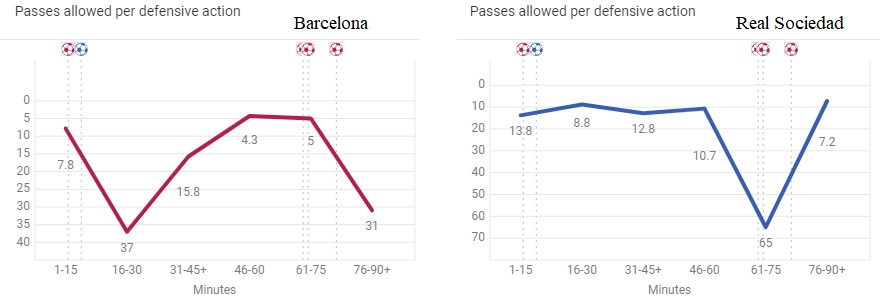
You can see the teams’ respective PPDA values in the graphic above. It has to be noted, however, that this was only a temporary solution. Barcelona would change their approach once more, this time upping the aggression and pushing the opposition back through heavy pressing. The first shift happened between minutes 45-60, which was the true breaking point of the game.
Barcelona’s match tempo reached its first peak between 30-45’ as the Catalans registered 18.24 passes per minute of possession, forcing La Real back. This period is interesting because it saw the biggest participation of all three of their midfielders, most notably Pedri’s, whose number of received passes spiked from seven to 18. Alguacil’s troops tried to fight it but it was very difficult to sustain their highly aggressive pressing strategy.
We’ve seen their fluctuating PPDA numbers in the earlier graph and between minutes 31-45’+, it rose to 13.5 from 8.17. However, they had enough strength for one final huzzah after the break, although at this point they were already visibly exhausted.
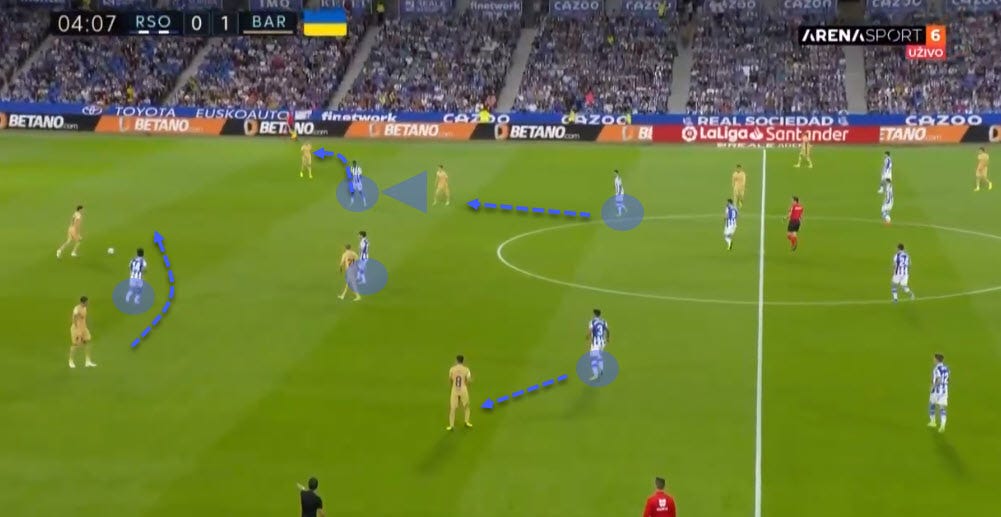
Above is Real Sociedad’s pressing structure. Granted, there were some slight tweaks by Alguacil but they generally pressed in a 4-1-2-3 to mimic Barcelona’s 3-2-2-3 and then in a variation of a 4-3-3 (or 4-diamond-2) later on where David Silva would sit on De Jong while the forwards tracked the wide defenders, as pictured above. The idea was to send Barcelona wide or force them to play long through Marc-André ter Stegen or Ronald Araújo, who was often intentionally left free, exploiting his on-the-ball deficiencies.
Even before the break, however, the cracks were starting to show. Real Sociedad were running on fumes and Barcelona were running rampant despite no real threats to their opposition’s goal just yet. Even though the last 15 minutes of the first half only yielded 0.16 xG, Barcelona retained control, racking up 119 passes (94.12%), a significant jump from 62 passes (90.32%) they mustered between minutes 15-30 and boasting 59.45% possession, an improvement on their 53.63% from the previous 15-minute period.
And with 18.24 passes per every minute of possession, Real Sociedad were being dragged all across the pitch. The results can also be seen in the GIF below.

We can see that this isn’t a case of Real Sociedad breaking their structure or not sticking to the plan; it’s Real Sociedad not being able to execute their plan with the same intensity anymore. There’s a big difference between the two. After the break, Barcelona upped their intensity once more, playing fewer average passes per possession but being extremely direct and aggressive both on and off the ball.
In the first 15 minutes of the second half, just before the substitutes happened, they completely broke their opponent. With 3.86 PPDA (high aggression), (so far) game-high 62.23% possession and 0.45 xG, Barcelona were now biting back. La Real tried to retaliate with pressing of their own (8.17 PPDA) but 15 minutes of defending is all they had left in them. After that, their PPDA sky-rocketed to 70, meaning they could only sit back and barely hold onto their lives, letting Barcelona dominate the affair.
Around the hour-mark, in came Ansu and Raphinha to tackle those tired legs. And then it was game over for the home side.
Final remarks
There’s no doubt what happened post-minute 60 is what truly marked the whole game. Real Sociedad went from being on par with Barcelona to getting completely left in the dust behind Xavi’s machine in what seemed like moments at best. However, the whole thing was by design; a design that took a whole hour to set up.
The idea was clear from the beginning but the execution wasn’t right at the very start of the game. It all got better, however, from that 15-minute mark, starting with Pedri and Gavi swapping places. But even that didn’t give the sensation of control, at least not until you delve deeper into the numbers, unearthing a slow but steady rise from Barça and a plunge into darkness from Real Sociedad.
It took Xavi around an hour but he succeeded in breaking down the opposition until they were not able to keep up anymore. That needs to be applauded. But he also got a lot of things wrong on the night, which resulted in Barcelona’s early struggles. Still, we have to remember this project is a work in progress and should be treated as such. Experimenting is good to a certain extent but at one point, Xavi will have to find his identity.
Until then, we’ll keep dissecting the good, the bad and the ugly.

